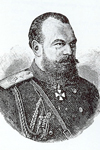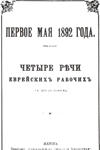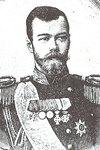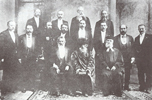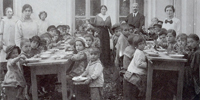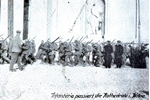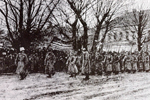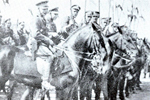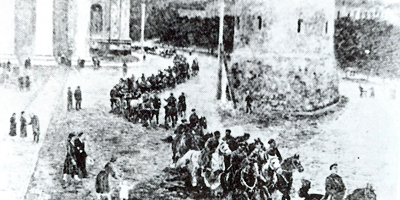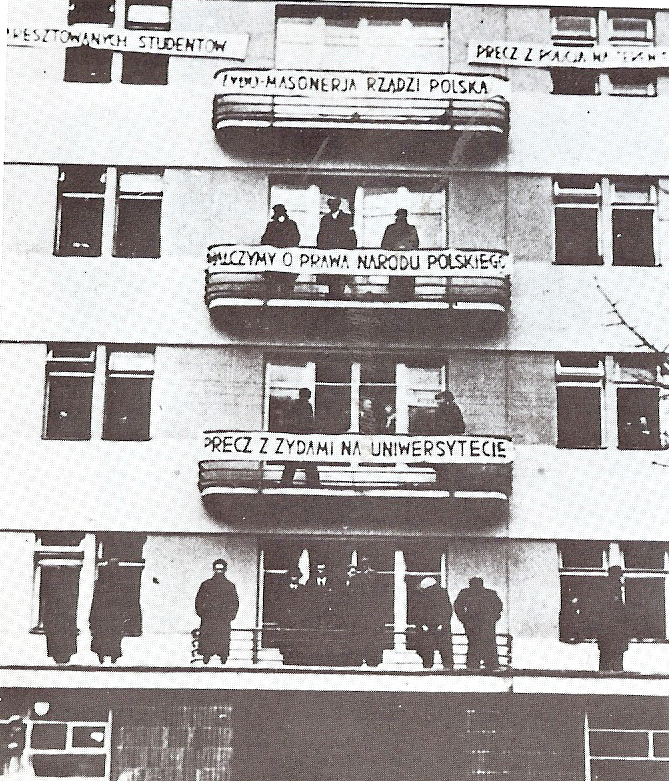|
|
The official website of Until Our Last Breath: A Holocaust Story of Love & Partisan Resistance published by St. Martin's Press and maintained by author Michael Bart. |
|
Outburst for Revolution"Expulsions, deportations, arrests, and beatings became the daily lot of the Jews, not only of their lower class, but even of the middle class and the Jewish intelligentsia. The government of Alexander III waged a campaign of war against its Jewish inhabitants...The Jews were driven and hounded, and emigration appeared to be the only escape from the terrible tyranny of the Romanovs."1 Berel Wein
Triumph of Survival
The Height of RussificationAt the height of Russification and conscription during the reign of Czar Nicholas I, Jacob Brafmann aspiring for advancement into the Orthodox Theological Seminary, published a series of articles in the Vilna Messenger. After the death of Nicholas I, Brafmann sent a memorandum to his successor Czar Alexander II in 1858 with false accusations against the Jewish community.2
Brafmann tried to prove that the executive organ of the Jewish community had formed a 'state within a state.' Even though Czar Alexander II continued to grant positive rights to the Jewish community, Brafmann's false accusations were published in two volumes he authored in 1869 and 1871 called, Book of the Kahal.3
The book was instrumental in spreading anti-Judaism in the Russian Empire.4 With Brafmann's false accusations in publication, the State Council appointed a special commission of representatives in 1870 that created a ten year study group that focused on the elimination of the fabled power held by the heads of the Jewish community and on the extension of the Pale of Settlement.5
Back to Top Pogroms under Czar Alexander IIIOn March 13, 1881 Alexander II was assassinated. His son, Alexander III (1881 - 1894) succeeded him and reversed the course of progress his father had advocated, organizing one pogrom after another to keep the anger of the masses focused on the Jews. Czar Alexander III appointed Pobiedonostzev Procurator of the Holy Synod who implemented a solution to what was perceived as a Jewish problem in Russia. Pobiedonostzev introduced wide-spread pogroms as a solution. His plan was to absorb one-third of the Jews into the Russian Orthodox
Back to Top Revolutionary Response
Vilna's Jewish students who were forced into Russian schools were introduced to radical ideas written by Russian revolutionaries
who aspired to overthrow Czarist rule. The doctrine of 'Populism' written as a solution for liberating the Russian masses aroused the Jewish youth in Vilna. Beginning in 1886, small circles of students began to form revolutionary groups with various ideas and aspirations for the achievement of liberty and equality. Jewish workers organized the first May Day demonstration in the city that was dispersed by the police in 1892. Revolutionaries caught by the Vilna Police were sentenced to prison, or banished to Siberia. The discovery of illegal revolutionary circles resulted in discussions within the State Council to alleviate congestion in the Pale of Settlement.10
The majority of Russia's annexed population was devoted to the Roman Catholic Church, and to Polish nationalism. Polish nationalists--both Christians and Jews--took part in a succession of uprisings against Russia--first in 1794, then in 1830-1831 and 1863.
The rise of the Polish national consciousness in Vilna was strengthened by Adam Mickiewicz, who was banished by czarist secret police in 1823 to his exile in Paris, along with other emigre Polish patriots.11 By 1892, Josef Pilsudski had founded the Polish Socialist Party. As a leader of the revolutionaries in Vilna, Pilsudski was determined to rebuild and rule an independent Polish State. Although, the Jews and Poles had the same goals there were no formal agreements between them. The Jewish workers feared that living under a Polish ruled state would be no better than the Russian Empire and considered a socialist empire in Russia to be a better alternative.12
Back to Top An Outburst for Revolution in 1905The growing revolutionary sentiment amongst Russians under czarist rule led to the formation of two large parties: the Social Democrats and the Social Revolutionaries. Jews who espoused the socialist cause joined either the Social Democrats or the Bund, a purely Jewish organization founded in Vilna in 1897. The Bund demanded reduced working hours and higher wages and aspired to political liberty through the distribution of leaflets and broadcasts. The Bund met in Bialystok in 1901, and adopted a resolution that the various nationalities within Russia "be organized on federative principals,
In 1903, portions of the Protocols of the Elders of Zion were published in a Russian newspaper in St Petersburg called the Znamya (Banner), and later were published as an appendix in The Great in the Small written by Russian mystic and writer Sergei Nilus. Although the origin of the falsehoods is debated, most academic historians suggest the fabrication was produced by the foreign branch of the Russian secret police in Paris. In order to quell mass Russian discontent of the oppression and brutality of the czarist regime under Nicholas II, the Russian secret police used the falsehoods against the Jews. The Russian secret police was using the Jews as scapegoats--blaming the Jews for Russia's ills; thus diverting attention to the Jews and away from the czar. By far this work of fiction was the most damaging forgery ever to be disseminated for mass publication.
Early in 1905, Vilna's Jewish community, together with thirty other communities nearby, petitioned the Russian government to abolish restrictive anti-Jewish laws so that Jews, "in possession of freedom and equality, can work hand in hand with the other citizens of the great empire for its welfare and prosperity." One of the groups considered to be radical at the time wanted to add to the petition, "As a civilized nation we claim the right to national cultural self-determination, which must be conceded to all peoples
composing the Russian Empire."15 In April of 1905, all of the principal communities met in Vilna, forming the Union for Equal Rights. The Union was a joint creation of liberals and Zionists that demanded political and national equality for Jews in Vilna under czarist rule who asserted, "the Attainment of Complete Emancipation for the Jewish people in Russia." Czar Nicholas II's response to abolishing restrictions placed on Jews was, "As long as I rule, the emancipation of the Jews in Russia is not to be thought of."
Theodor Herzl visited St. Petersburg to ask the Governor of Vilna to refrain from suppressing Zionist activities and to promote a Jewish settlement in Palestine with mass emigration from Russia. Within a year both the Governor of Vilna and Theodor Herzl were dead. Many Jews who took part in the revolutionary movement were imprisoned, banished, or hanged. Some Jews escaped, fleeing to America--the land of liberty and freedom.16
Back to Top World War I & Eight Different Governments (1914 - 1922)"One has to bear in mind that with the frequent change of rulers the name of the city would change as well...under Russian control the city was called [W]ilna; under Polish administration Wilno, and under Lithuanian rule Vilnius. In German it is Wilna, in Yiddish Vilne, and in Hebrew Vilna."17 Between the eight year
In 1917, the Bolshevik Revolution toppled the czarist regime. Late in the year, the Balfour Declaration was signed in favor of a Jewish national homeland in Palestine. The Zionists in Vilna felt that the Russian Revolution was part of the reason for the support of the British government. The organization of Zionists in Vilna greatly increased. With the collapse of the Kaiser's army in 1918, and the end of WWI, the German troops vacated the city.20
After the Germans left the city, there was a time of confusion. The Poles and Lithuanians both fought for control over the seats in parliament and courted the Jews for support.
On April 19, 1919 the Polish army, under the command of Josef Pilsudski, again re-captured control of the city.
On July 12, 1920 the Lithuanians and Russians signed an agreement to re-take Vilna, and both began a march towards the city. The Poles wanted the Jews to help in the battle. The Jews went into hiding afraid of both the retreating Poles and the advancing Russians.
Upon capturing the city two days later, the Bolsheviks arrested both Poles and Jews, and renationalized the factories. After six weeks in the city, the Bolsheviks handed the government over to the Lithuanians as they had earlier agreed. A provisional Lithuanian government was formed representing four nationalities. The people of Vilna began to believe that national cultural autonomy could be achieved.26
General Zheligovski, on October 8, 1920 first announced the Vilna area as the new State of 'Middle Lithuania.'
Back to Top Vilna under the Polish Republic (1922 - 1939)With 'Middle Lithuania' eliminated, the State's policies were replaced by Poland's government in Warsaw.
In contrast to the economic depression was the robust cultural life of the Vilna's Jewish community. Like the Lithuanians and the White Russians, the Jews of Vilna were loyal to the Polish State but their ethnic individuality was very important to their community. The desire for ethnic identity was misunderstood abroad, however from the viewpoint of Vilna's Jews the Versailles Treaty assured them of their right to maintain linguistic equality under Polish rule. The Jews of Vilna were very proud of their Litvak heritage characterized by the Yiddish they spoke in a standard of its own. In 1925, the Yiddish Scientific Institute, known as YIVO, was established through honoree board members such as Albert Einstein and Sigmund Freud. The purpose of the three-story building was to collect and document Yiddish books, periodicals, and pamphlets to promote research. It contained vast collections from all over Europe illustrating various aspects of Jewish life and culture that was divided into sections: history, sociology, philology, pedagogies, art, drama, music and folklore. Showcases displayed rare revolutionary pamphlets in Yiddish and the history of Socialism from different countries. Included in the archive were five Yiddish daily periodicals and monthly magazines fostered through the creative spirit of the Romm Printing Press. By 1932, there were about 75,000 Jews within the total population of 200,000 in Greater Vilna.31
Back to Top The Rise of Poland's Endek PartyWith Germany's Nazi Party's rise to power in 1933, Vilna experienced increased reaction that was aggravated by economic and political discrimination.
By 1935 the Jewish Council was financially sound and was able to create a system of welfare in Vilna. The primary obligations of the Jewish Council was to furnish subsidies for the staff at the Strashun Library, the various educational institutions, a soup-kitchen for the needy, and emigration to Palestine. Many young Jewish men and women sought admittance to the "He Halutz" to be trained on a farm in preparation for emigration to Palestine. Widespread poverty in Vilna's Jewish community at Passover in 1938, resulted in the numbers of Jews dependent on communal relief to amass to 25,000 out of 60,000 individuals. The poorest community in Vilna was the Jewish ghetto. The houses that had been inhabited by well to do merchants and manufacturers had been reduced to slums.35
Back to Top Immigration Quotas for America & British mandated PalestineWith the rate of unemployment and poverty in Vilna there were Jews hoping to emigrate to other countries, however, most found the task an unrealistic goal. The quotas for immigration into America with Polish origin that included Polish Jews were too small to accommodate the many who sought refuge. American immigration quotas set in the 1920's, remained low in the 1930's. After Kristallnacht, on November 9, 1938 the German Jews took priority over the Polish Jews. With a growing refugee problem in Germany in 1939 and 1940, President Roosevelt maintained the yearly immigration quota set for German, Austrian, and Czechoslovak citizens which included Jewish citizens of the respective countries, at a combined total of 30,244. When America entered into the war in 1941, Nazi Germany blocked their exits. America continued to tighten up immigration quotas until the doors shut. Palestine wasn't an option either. In the Spring of 1939, Britain had capitulated to Arab demands and restricted Jewish immigration to 15,000 per year. However, the British did not permit the set quota to be filled. This was a disappointment for the Zionists in Vilna, and elsewhere in Europe.36 Although the Great Powers had shut their doors to immigration, in Kaunas, Japanese diplomat Chuine Sugihara issued nearly 6000 transit visas in defiance of his government to Jewish refugees coming from Germany, Poland and Lithuania. Consul Sugihara described the condition of the refugees at the gate of his Consulate in July 1940:
"These people had walked for many days under severe conditions, dragging themselves on painful feet and enduring countless hardships. Their objective was to reach Kaunas. What they wanted was, somehow, for the Japanese Consulate to issue transit visas that would allow them to travel through the Soviet Union in order to escape the Nazis. The refugees walked regardless of the weather. Some walked along the railroad, dragging painful feet, and some of the more fortunate rode in wagons."37
Notes1. Berel Wein, Triumph of Survival, 173.
2. Cohen, Vilna, 287.
3. Ibid., 288.
4. Beitler Family Foundation, The Timechart History of Jewish Civilization, 10: "The first known use of the word anti-Semitism was in 1879 by a German agitator."
5. Cohen, Vilna, 289.
6. Ran, vol 1, Jerusalem of Lithuania, XIX; Cohen, Vilna, 293 - 294.
7. Cohen, Vilna, 295.
8. Ibid., 296; Gutman 896.
9. Ran, vol 1, Jerusalem of Lithuania, XIX; Cohen, Vilna, 333.
10. Cohen, Vilna, 340, 339, 290.
11. Dawidowicz, From that Place and Time, 30.
12. Ibid., 31; Cohen, Vilna, 340.
13. Cohen, Vilna, 346 - 347; Olgin, The Soul of the Russian Revolution, 93; Theodor Herzl published Der Judenstaat, the Jewish State 1896 after witnessing mobs in France shouting, "Death to Jews." when Captain Alfred Dreyfus was framed for treason, the church, government and army united to conceal the real culprit. With increased anti-Semitism in France over the Dreyfus Affair, Herzl decided that the only solution for European Jewry was to acquire a land of their own. The Dreyfus Affair became one of the factors in the organization of Political Zionism.
14. Cohen, Vilna, 299.
15. Ibid., 300.
16. Ibid., 300 - 301; Bart, Until Our Last Breath, 21. According to genealogy done in 1985: Some Jews involved in revolutionary activities fled to America, such as Bluma Balcwinik's daughters, Lizzie and Rose. Lizzie arrived in the United States at the age of 15 "in order to avoid arrest due to czarist activities. Worked in corsette factory in Springfield, [Mass.]. Returned to Vilna after hearing about the 'easy life' from [her younger] sister Rose." Her brother Barney was involved with his sister in the Hashomer Hatzair and was part of the 1905 revolution. Barney came to the United States to escape the police.
17. Shneidman, Three Tragic Heroes, xi. According to Shneidman under Russian control the city was Vilna, however the Bart's postcards posted on the video link on this website show that the spelling is Wilna. Both are both correct, since the city was pronounced Vilna.
18. Cohen, Vilna, 359. According to Lewinson-Balcwinik family genealogy done in 1985: Aaron [Balcwinik] Fineberg "came to the US first at 15, was sent back due to lack of proper papers. Returned to US at 16. Arrived Hoboken, NJ on the ship, Birma, left from Libau, Russia. Ran away from Russian army. Worked in NY soldering tin roofs."
19. Ran, vol 1, Jerusalem of Lithuania, XIX.
20. Cohen, Vilna, 361 - 363.
21. Ibid., 369.
22. Ibid., 373 - 374.
23. Ibid., 374 - 376.
24. Dawidowicz, From that Place and Time, 31; Cohen, Vilna, 378 - 9.
25. Cohen, Vilna, 380 - 381.
26. Ibid., 382.
27. Ran, vol 1, Jerusalem of Lithuania, 30; Cohen, Vilna, 383 - 387.
28. Cohen, Vilna, 388 - 389; Lauren, Paul Gordon, The Evolution of International Human Rights, University of Pennsylvania Press, Philadelphia, 93-94; Texts in Societe des Nations/League of Nations, Document C.L.110. 1927. I, Annex, Protection of Linguistic, Racial, and Religious Minorities (Geneva: Societe des Nations, 1927).
29. Cohen, Vilna, 398; Dawidowicz, From that Place and Time, 169.
30. Cohen, Vilna, 403 - 404.
31. Ibid., 408, 413.
32. Ibid., 418 - 419.
33. Ibid., 419.
34. Dawidowicz, From that Place and Time, 169; Cohen, Vilna, 420 - 422.
35. Cohen, Vilna, 405, 391.
36. Feingold, Henry L. Politics of Rescue: The Roosevelt Administration and the Holocaust, 1938 - 1945, 44, 131; Wyman, David S. Abandonment of the Jews: America and the Holocaust, 5 - 7, 157. Established in the 1920's, immigration quotas were given specific limitations on the number eligible to immigrate to the United States in any given year, from any given foreign country. Eligibility was based on country of birth. For example, there was a German quota, a British quota, and so on. The total of all quotas was 154,000. Almost 84,000, was assigned to the British and Irish.
37. Sugihara, Yukiko, Visas for Life, 3 - 4.
|
||||||||||||||||||||||||||||||||||||
Outburst for Revolution - Page 2 of 6
